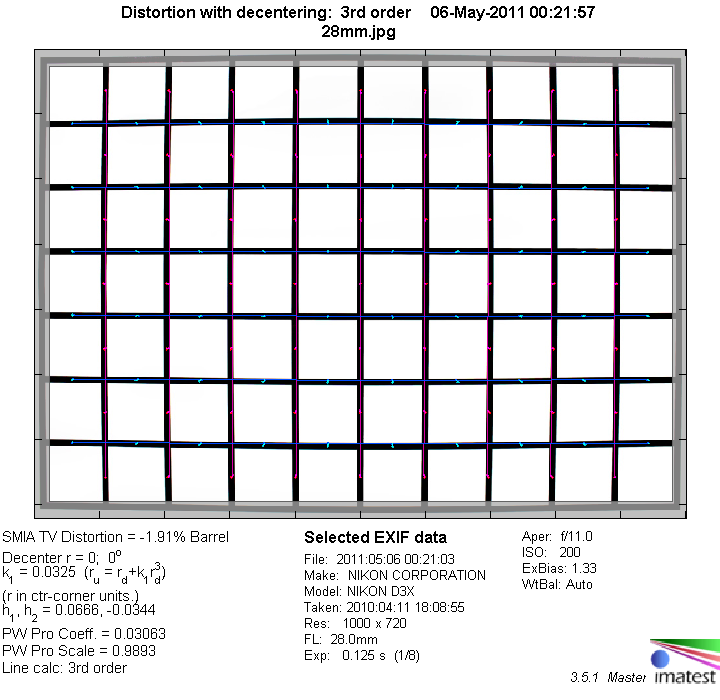|
Nikkor AF 28mm f/2.8 D (FX) - Review / Test Report - Analysis |
|
Lens Reviews -
Nikon / Nikkor (full format)
|
|
Page 2 of 3

Distortion
The lens shows barrel distortion at around 1.9%. This can be visible and disturbing for subjects with straight lines near the image border. However, the distortion is uniform and thus easy to remove in post processing.

The chart above has a real-world size of about 120x80cm.
Vignetting
The Nikkor shows very pronounced light falloff towards the image corners wide open and also at f/4. Stopped down to f/5.6 and beyond vignetting is reduced to a level that is no longer an issue for most subjects.
We're performing our vignetting analysis based on
(uncorrected) JPEGs straight from the camera. The JPG engine of the Nikon D3x features a rather flat
gradation curve, thus has a moderate contrast characteristic, resulting in comparatively low vignetting figures - the
corresponding Canon figures are roughly 40% higher due to the more
aggressive default contrast setting.

MTF (resolution)
In the image center the lens shows very good resolution wide open already, reaching excellent sharpness from f/4 onwards (until diffraction limits the maximum achievable resolution at f/11 and beyond).
The borders and corners follow quite a bit behind. Wide open the borders show good reolution, the corners are very soft, though. Stopping down helps to increase reolution, but even at their peaks borders and corners only just reach very good resolution figures.
Please note that the MTF results are not directly comparable across the different systems!
Below is a simplified summary of the formal findings. The chart shows line widths
per picture height (LW/PH) which can be taken as a measure for sharpness.
If you want to know more about the MTF50 figures you may check out the corresponding
Imatest Explanations

Chromatic Aberrations (CAs)
Chromatic aberrations (color shadows at harsh contrast transitions) are well controlled at large apertures, but increase considerably by stopping down. However, CAs can easily be corrected in software or by the camera itself (if you shoot JPEGs and own a current Nikon DSLR).

Bokeh
A 28mm prime is not primarily designed to throw the background out of focus (to the contrary, actually). However, with its ability to focus rather close combined with the large aperture the lens is able to separate the main subject from the background (at least for larger subject-to-background distances). So, let's have a quick look at the bokeh quality.
Out of focus areas show some nervousness and double contures. Background highlights are somewhat distorted towards the image borders at f/2.8 and f/4 From f/5.6 onwards the aperture shape with its straight blades (not rounded) starts to become visible here. Quite strong outlining increases the overall unpleasant character of the lens' bokeh.

|